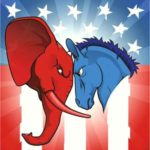Among political pundits, strategists and Republican insiders, a debate has emerged over similarities between Donald Trump and Ronald Reagan.
Those who idolize the deceased president scoff at such comparisons. But others have noted numerous connections between the two, particularly their rise to the pedestal of GOP presidential nominee.
Like the presumptive nominee of 2016, Reagan was a former Democrat who moved to the right over time. He became embroiled in presidential politics late in life, thrived as a controversial national figure, and used his show-business sensibilities to his advantage on the campaign trail. Both stumbled over basic policy matters.
Unlike Trump, Reagan previously served two terms as governor of California, the country’s most populous state, and ran twice for the White House (in 1968 briefly and in 1976) before securing the 1980 nomination.
Those who champion the Reagan legacy note that he was nothing like the caustic Trump in terms of style. Rather than seethe with anger and resentment, the Gipper projected a sunny optimism. He followed a strict ideology that embraced America’s role as an international leader with projections of military power in every corner of the globe.
Several examples have emerged in recent weeks when the Reagan White House shunned Trump, sometimes in dismissive ways. It became apparent that Trump, though a major Democratic campaign donor, sought to latch onto Ronald and Nancy Reagan’s popularity. In one internal memo, a top Reagan aide warned that the real estate mogul has “a large ego,” with the word large underlined. In retrospect, the word “huge” probably would have been a better choice.
Michael Reagan, the former president’s staunchly conservative son, weighed in recently, insisting that his father would not have supported or voted for Trump as the GOP nominee in the fall.
Not so fast
Yet, the comparisons cannot be dismissed so easily.
Frank Rich is about as liberal as it gets among the columnists of the mainstream media. So, when he wrote a piece earlier this month for New York magazine comparing Trump to Reagan, it appears that many political observers dismissed it as a hit piece. In fact, it is a lengthy, lucid review of many forgotten historical moments in politics, big and small.
This is not a snarky Trump-bashing piece by any means, even if Rich’s contempt for the bombastic billionaire is barely concealed, from time to time. Since his commentary was published, a website as far right as Newsmax found 15 similarities between Reagan and Trump.
In making the case that Trump represents a third wave of conservative populism (with Barry Goldwater leading the first charge and Reagan succeeding as the standardbearer of the second movement), Rich takes the reader on a journey that leads to numerous connections between Reagan and Trump which explain the real estate tycoon’s improbable campaign success, as he now stands one step away from the presidency.
The piece reminds us of just how disliked and feared Reagan was among the Republican Party establishment in his long lead-up to the 1980 election. In fact, the GOP leadership was far closer to unanimous opposition to Reagan than the rag-tag resistance Trump has faced from inside the party.
Perhaps the strongest case that Rich makes in portraying the Reagan-Trump similarities revolves around campaign memos and strategic advice supplied to the former president during his runs for the president in 1968 (briefly), 1976, 1980 and 1984.
In one, Reagan pollster Richard Wirthlin correctly predicted the path toward victory in 1980. Voters wanted to “follow some authority figure,” he advised, a “leader who can take charge with authority; return a sense of discipline to our government; and, manifest the willpower needed to get this country back on track.” Rich points out that Reagan and Trump similarly campaigned as a prospective leader from outside Washington who projected a no-nonsense image (“You’re fired!”), whether they each had the ability to deliver on it or not.
While Trump sharply criticized Reagan during his presidency, Rich asserts that “the Reagan model has proved quite adaptable both to Trump and to our different times.” The columnist compares Trump’s tenure as an NBC reality-show host to Reagan’s stint hosting the highly rated General Electric Theater for CBS during the Ed Sullivan era. Trump’s embarrassing turn as a supporting player in a 1990 Bo Derek movie (Ghosts Can’t Do It), under Rich’s thesis, is no more egregious than Reagan starring opposite a chimp in Hollywood’s Bedtime for Bonzo of 1951.
Underestimated by the media
More substantively, Trump in 2016 has dodged criticism about his two divorces and three wives far more skillfully than we can imagine any other presidential candidate could have accomplished. And in the 1960s, as governor of California, and in the 1970s, as an emerging presidential contender, Reagan easily brushed aside criticism of his prior marriage breakup and smashed a cultural barrier by becoming the first White House occupant to have divorced and remarried. Neither candidate paid a price with the Evangelical right for deviations from the family-values norm, as they respectively snared the endorsements of Jerry Falwell and Jerry Falwell Jr.
Here are more of the connections Rich presents between these two seemingly different politicians who each demonstrated surprising political popularity:
Much of the (1980) press was slow to catch up, too. A typical liberal-establishment take on Reagan could be found in Harper’s, which called him Ronald Duck, “the Candidate from Disneyland.” That he had come to be deemed “a serious candidate for president,” the magazine intoned, was “a shame and embarrassment for the country.” But some reporters who tracked Reagan on the campaign trail sensed that (big crowds of) voters didn’t care if he came from Hollywood, if his policies didn’t add up, if his facts were bogus, or if he was condescended to by Republican leaders or pundits. As Elizabeth Drew of The New Yorker observed in 1976, his appeal “has to do not with competence at governing but with the emotion he evokes.” As she put it, “Reagan lets people get out their anger and frustration, their feeling of being misunderstood and mishandled by those who have run our government, their impatience with taxes and with the poor and the weak, their impulse to deal with the world’s troublemakers by employing the stratagem of a punch in the nose.”
… But Reagan’s and Trump’s opposing styles belie their similarities of substance. Both have marketed the same brand of outrage to the same angry segments of the electorate, faced the same jeering press, attracted some of the same battlefront allies (Roger Stone, Paul Manafort, Phyllis Schlafly), offended the same elites (including two generations of Bushes), outmaneuvered similar political adversaries, and espoused the same conservative populism built broadly on the pillars of jingoistic nationalism, nostalgia, contempt for Washington, and racial resentment. They’ve even endured the same wisecracks about their unnatural coiffures. “Governor Reagan does not dye his hair,” said Gerald Ford at a Gridiron Dinner in 1974. “He is just turning prematurely orange.” Though Reagan’s 1980 campaign slogan (“Let’s Make America Great Again”) is one word longer than Trump’s, that word reflects a contrast in their personalities — the avuncular versus the autocratic — but not in message. Reagan’s apocalyptic theme, “The Empire is in decline,” is interchangeable with Trump’s, even if the Gipper delivered it with a smile.
Photo: Trump campaign






